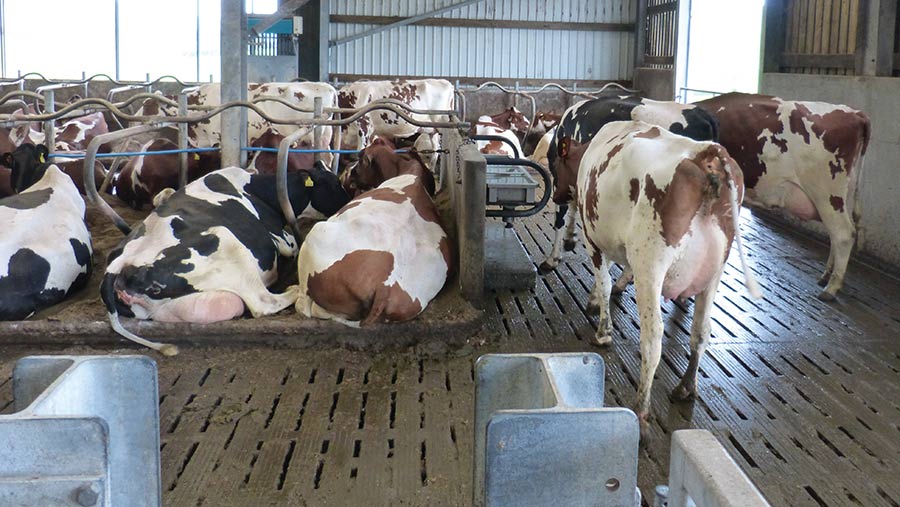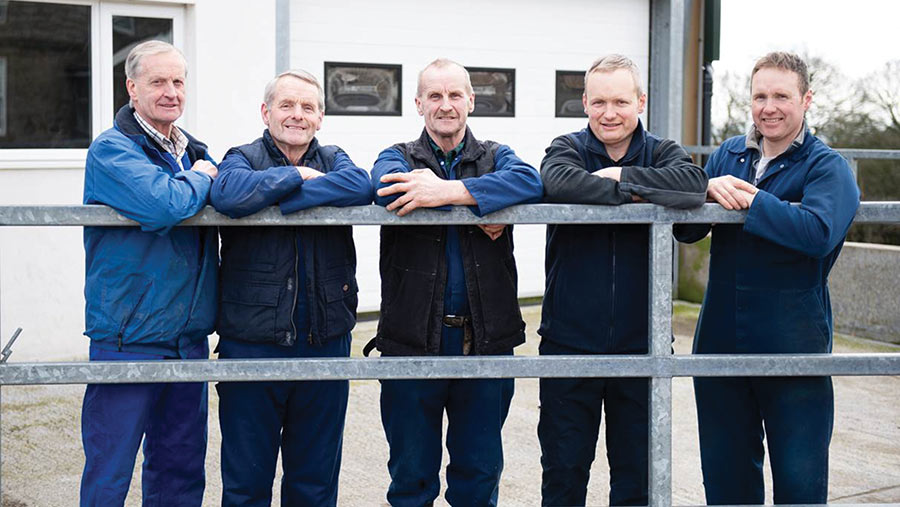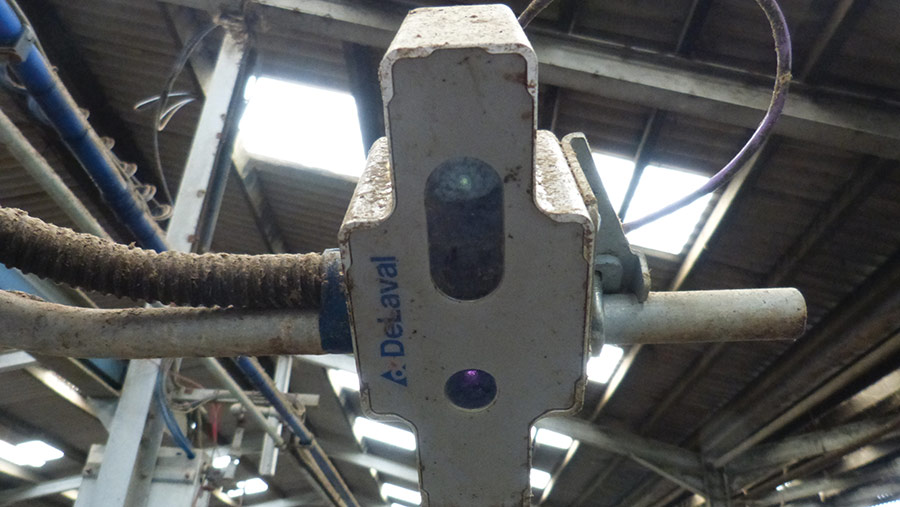Gold Cup winners share body condition scoring strategy
 © MAG/Michael Priestley
© MAG/Michael Priestley Embracing technology and keeping a close eye on cow condition have helped maintain pregnancy rates at 23% and support cow longevity at an Ayrshire family farm.
The Logans, from Holehouse Farm, Kilbirnie, took this year’s Royal Association of British Dairy Farmers/NMR Gold Cup home for their attention to detail and strong performance across the board.
Brothers Alistair and Stuart, father Tom and uncles Alex and Hugh all farm in partnership.
The farm has invested heavily in infrastructure and technology over the past nine years, which Alistair Logan says is now allowing the genetic merit of the herd to be realised.
See also: How a 540-cow dairy benefited from recycled bedding
In operation at the mixed dairy, sheep and suckler farm are:
- a Lely Juno (feed pusher)
- Lely Discovery slat-scrapers
- a recycled manure bedding system
- automated ventilation curtains
- ADF milking clusters
- an automatic electric foot-bath
- a body condition scoring camera.
But central to hitting a daily yield of 34 litres in a twice-a-day milking system – and a calving interval of 375-378 days – is focusing on cow condition and good stockmanship, explains Alistair.
“We have expanded the herd, but we are still at that level where we know individual cows,” he says.
The dairy requires two-and-a-half labour units from the partnership and two staff to do all feeding, breeding and milking work.
Holehouse Farm
- 280 pedigree Holstein cows suppling Muller on a direct contract
- 10,600 litres a cow a year
- 4.1% fat and 3.4% protein
- 23% pregnancy rate
- 1,930ha
- 10kW solar panels, 150kW biomass, 950kW hydroelectric and 3MW wind turbine
- 160 suckler cows and 1,600 Blackface ewes
- Sells 100 fresh heifers at Carlisle each year

Alex, Tom, Hugh, Alistair and Stuart Logan believe a focus on body condition score at Holehouse Farms is driving performance © RABDF
Historical condition scoring
Advisers stress the textbook strategy to monitoring and recording body condition score (BCS) is at the following times:
- Calving
- 60 days in-milk
- 100 days before drying-off
- Drying-off
However, Alistair admits the farm used to go on a “gut feel” and manage certain individuals, rather than regularly recording cow condition.
The main times for tailoring feeding and managing cows were at calving and drying-off.
“Fluctuating cow condition used to be more of an issue when we grazed in summer, and grass availability and weather would vary.
But now, as zero graziers, it’s easier to manage with a more constant environment and diet inside.”
Current strategy
The present strategy is to always keep cows at score 2.5-3.0, adjusting out-of-parlour feeders if necessary.
This allows simplicity elsewhere on the farm, as only three diets are mixed in the feeder wagon: miking cow, dry cow and youngstock.
A total mixed ration based on homegrown silage, straw, brewers’ byproducts, a protein blend, minerals and yeast is fed once a day to the cows to provide energy for maintenance plus 28 litres.
Cows are rationed to eat 56kg freshweight, or 22.5kg dry matter. The out-of-parlour feeders then feed to yield at 0.4kg/litre, which for a cow giving 55 litres amounts to about 11kg/day.
Fourth-cut silage this year analysed at 36.2% dry matter, 17.9% crude protein, 11.3MJ metabolisable energy and had a D-value of 70.3%.
The Logans say the following strategies towards managing BCS are helping to drive performance:
1. Different people
The Logans know the cows best and see them the most, but veterinary expertise is useful: having another set of eyes across the herd can pick up things that might get missed, says Alistair.
He uses farm vet Michael Fallon, and the team at MBM Veterinary Group, to conduct fortnightly assessments when pregnancy checking and look at individual cow and herd condition.
2. Simple but adjustable feeding
The out-of-parlour feeders are programmed to cut feeding off six weeks before drying-off, which is 12 weeks before calving. But this can be adjusted to 0.1kg according to cow condition.
3. Pragmatic drying-off
The farm manages to run a short dry period and longer lactation lengths of 334 days which average 11,011kg.
Most cows are dried off 42-45 days before calving, but recently a cow had dropped to 18 litres at 10 weeks, so was dried off to stop her piling on too much weight on the milker ration.
Many cows still produce up to 35 litres six weeks pre-calving.
Alistair believes it’s a case of balancing extending calving intervals with fewer litres in the tank, and says the current calving interval of 375-380 days and an average of 160 days in-milk seem to be about right.
4. Automation
The farm installed a DeLaval body condition scoring camera in autumn 2020 and Alistair says the data it collects is accurate, plentiful, and hugely useful.
Unfortunately, the camera’s downtime is far too high, with more time spent broken than functional over the past six months.
When working, the camera can assess cow condition to one decimal place (for example, 3.1) and shows a seven-day and four-weekly average, alerting operators to trends.
The camera is fixed to the parlour exit gate, which means that (when fully functional) the cows are getting accurately assessed twice every day.
This fulfils the farm’s BCS monitoring requirements for Muller.
Importantly, a fresh calver that is losing condition rapidly is flagged up, as are cows getting overfat later in lactation.
This saves on parlour cake and means feed is turned into milk and fertility, rather than unnecessary fat.

Condition-scoring camera © MAG/Michael Priestley
Interlinked
Alistair believes it’s very rarely one thing alone that gets a farm to where it wants to be, but a combination of factors.
“You can’t tick every single box, but if you try to tick enough and tick the right ones, you start to get somewhere.”
The Logans see body condition as important, alongside pregnancy rate, cow longevity, yield and health to drive output and profit.
“Cows in good condition seem to have far fewer health problems. Very often you see a cow losing condition and before you know it, you are having to pick her foot up,” says Alistair.
Quality concrete kept clean by the scrapers, rubber matting on high-traffic areas near the parlour, and deep recycled manure solids bedding help hoof health through increased lying times.
And a Lely feed pusher programmed to push up on the hour, every hour, means cows get enough dry matter intake.
“I would say the feed pusher is worth roughly a litre a cow a day. When it breaks – and we have to do five push-ups through the day – we notice a yield drop.”
Cow longevity in the Holehouse herd is between three-and-a-half and four lactations. At the last count, 28% of the herd was in their fourth lactation or older, including six cows in their seventh lactation.
“Having cows that last is important, but there is a point when we possibly end up with an old herd and not enough new genetics coming in.
“The rate of genetic gain is important, and we have an artificially high replacement rate at 32% to get the genomically tested heifers in.”
